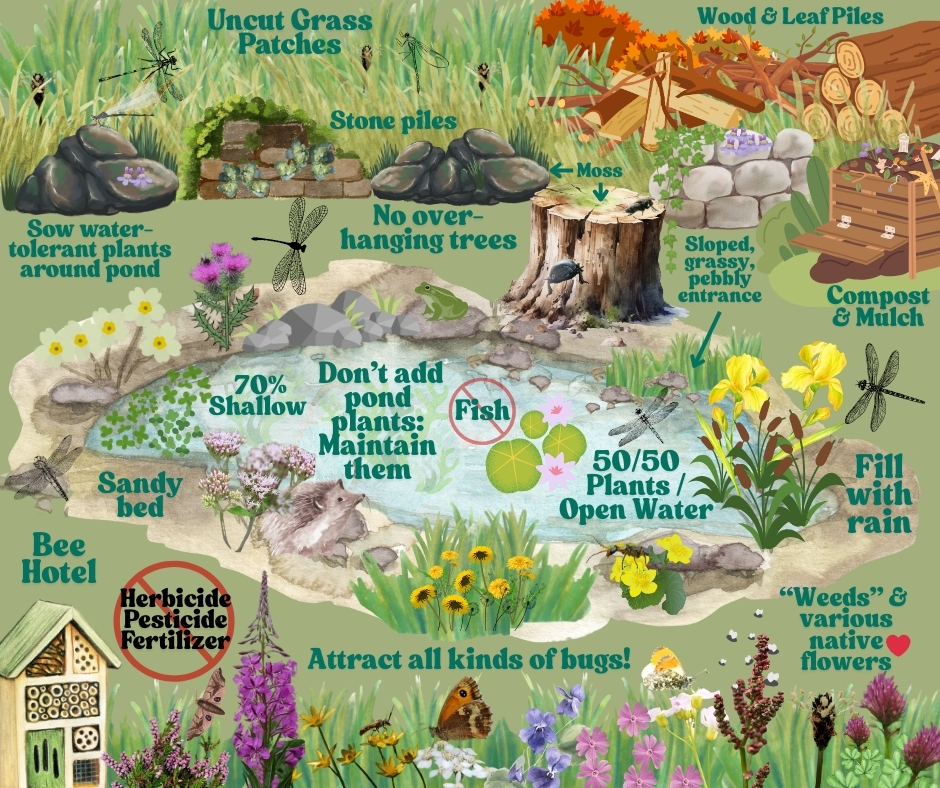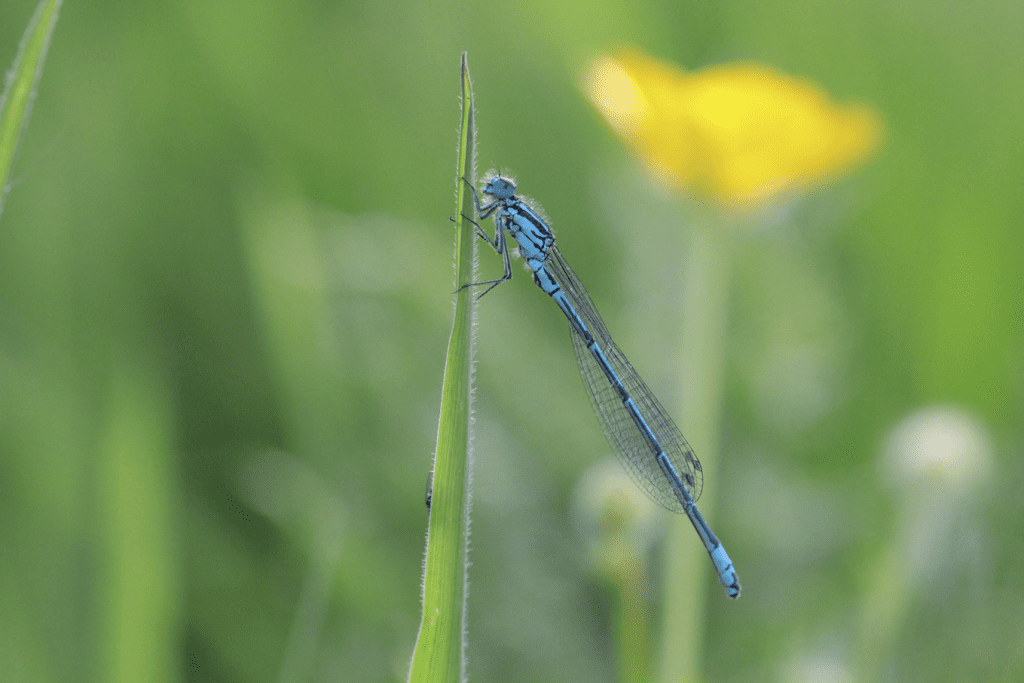Attracting dragonflies, as you probably know, requires a pond. Digging a pond in your garden, can easily be the single most helpful thing a person can do for nature. Even mini-ponds are extremely valuable and support an enormaty of life. But… to make it as beneficial as possible for wildlife, it is imperative to consider all the different life-stages of the creatures you’re attracting. In this respect, focusing on Dragonflies and Amphibians casts an excellent umbrella that will benefit all sorts of other species.

So, for dragonflies and damselflies (Odonata), you need to provide habitat for each of their four life stages:
Nymph
The key here is to provide hunting grounds and a variety of animals as prey!
Dragonfly nymphs are opportunistic and they’re the natural apex predator in a small pond, so we’re not vying for anything specific here, just as much habitat as possible for snails, tadpoles, diving beetles, bugs, leeches, isopods, fly larva, etc. Most of this habitat thrives in shallow water so aiming for ~70% shallow water is best.
- Rocks, stones, and sand provide areas for nymphs to hide and ambush their prey; this is also good mayfly, caddisfly, and stonefly habitat which are potential prey.
- Submerged vegetation, e.g., pond algae, Spiked Watermil-foil (Myriophyllum spicatum), and Ridged Hornwort (Ceratophyllum demersum) will soon colonise a new pond.
- Floating vegetation will spread to a new pond after a while; examples are, Frogbit (Hydrocharis morsus-ranae) and Common Water-crowfoot (Ranunculus aquatalis), and the native pond lily (Nymphaea alba) – though it can dominate smaller ponds.
- Marginal vegetation that grows on the pond’s edges like, lawn grass that trails into the pond and water-tolerant marshy/boggy plants, e.g., Marsh Marigold (Caltha palustris), Brooklime (Veronica beccabunga), Globeflower (Trollius europillworaeus), and Water Forget-me-not (Myosotis scorpioides) will eventually arrive on the wind or attached to animals.
This will all provide excellent habitat for the various prey species. Plants also oxygenate the water and help prevent algae from taking over, by absorbing excess nutrients.
If your old pond essentially only supports swathes of algae, then see the management section.
Metamorphosis
Strong vegetation like rushes, sedges, and yellow flag iris (Iris pseudacorus), that emerge from the water’s surface provide nymphs a vertical place to climb out of the water to moult their nymphal exoskeleton. It’s important that emergent vegetation receives a decent amount of sunlight in the spring/summer because emerging insects need to dry out; so, it is, therefore, best not to dig a pond under a tree or behind a south-facing wall.
Imago (adult)
Adult dragonflies are extremely active predators that will pursue all sorts of flying insects. Damselflies are also predators but tend to wait for prey to pass by before pursing. The best way to provide insect prey for Odonates, is to plant a bunch of native wildflowers species around the pond, have a bee hotel, and leave lots of loose piles of decaying wood, leaves, and compost. Additionally, leave uncut grassy areas, encourage weeds and moss, and always avoid any kind of chemical pesticide/herbicide. Also avoid fertilizers that could be rained into your pond. If you must use fertilizers, then keep to the organic kind and do so away from your pond. Nearby trees and/or native hedges including, hawthorn, blackthorn, bramble, hazel, ash, and/or oak, are also important to provide areas for odonates to safely rest. Adult odonates also like to perch and sun themselves, so adding piles of rocks, wooden posts, log piles, and standing dead branches will be perfect for this.
If you’re struggling to get native wildflowers to establish or thrive in your garden then check out PlantLife‘s website on making wildflower meadows – it’s full of excellent tips, such as, cutting yearly in early winter to remove grass and collect seed, and scraping the earth to leave bare soil before sowing seeds.
Any kind of “weed” is likely good for nature, but here are some wildflower species that will grow in most gardens if sown:
Cornflower (Centaurea cyanus)
Corn Marigold (Glebionis segetum)
Corn Poppy (Papaver rhoeas)
Hemp-agrimony (Eupatorium cannabinum)
Common Bird’s-foot Trefoil (Lotus corniculatus)
Field Forget-me-not (Myosotis arvensis)
Musk Mallow (Malus moschata)
Common Knapweed (Centaurea nigra)
Common Teasel (Dipsacus fullonum)
Hedge Bedstraw (Galium mollugo)
Field Scabious (Knautia arvensis)
Wild Marjoram (Origanum vulgare)
Selfheal (Prunella vulgaris)
White & Red Campion (Silene latifolia & dioica )
Hedge Woundwort (Stachys sylvatica)
Tufted Vetch (Vicia cracca)
Oxeye Daisy (Leucanthemum vulgare).
Egg
You already have lots of the habitat required for dragonfly eggs with the submerged and emergent vegetation, but what is equally important here is open water. Some dragonfly species, like the chasers, darters, and skimmers, lay their eggs directly into open water. A good rule of thumb is to aim for 50% vegetation and 50% open water on the surface. Scraping algae or floating plants to one side of the pond without removing it is the ideal strategy here because it does not disrupt the animals or eggs within them. Open water will additionally attract pond skaters, water stick bugs, waterboatman and whirligig beetles which are fascinatingly beautiful to watch.
All of this is great advice for frogs and newts too – but remember to consider their entire life cycles. Make sure they have easy access to the water, with a sloped bank as an entrance/exit. If, for example, you have a raised pond and this is not possible, then adding a sloping wooden plank into the water and up to the pond or piling stones on the edges is a good alternative. Additionally, piles of compost, leaves, smaller woody debris, loose soil, woody/rocky nooks and crannies are great for adult toads and newts to hunt and / or hibernate.
If you do all of that then you will have an ideal space for not only dragonflies, but other insects like beetles, butterflies, and bugs, as well as other animals like amphibians, small mammals, birds, reptiles, and all sorts of other invertebrates!
Things to AVOID:
- One thing you don’t want, is fish! Unless your pond is very large and also attracts birds, fish probably wouldn’t naturally occur there. They add unwanted nutrients to the water with their poo and provide substantial competition for prey. Fish even eat insect larva and nymphs.
- Trees over the pond – dropped leaves will add nutrients to the pond which can promote algae to take over. Consider adding netting over the pond or under the tree canopy to catch fallen leaves.
- Removing vegetation frequently, carelessly, or at the wrong time – To maintain open water habitat, try simply scraping vegetation to one side without removing it. But if your pond needs to be thinned of vegetation (including algae) then be mindful of the animals and eggs that may be attached. If possible, do this in early autumn, Sept-Oct, and either leave plants to the side of the pond for a few days to allow anything within to crawl back in, or remove and return creatures to the pond gently by hand. Remember to dispose of the plants after a couple of days, though, or they will rot and add unwanted nutrients to your water.
- Pesticide, herbicide, & fertilizers – This is somewhat obvious, but it is very important.
Additionally, don’t let your pets swim in the water if they have been treated for fleas/ticks/worms, especially if it was a topical chemical. It would also be a good idea to groom them indoors and dispose of the fur rather than letting it get taken by the wind. These pet treatments are extremely powerful and some of them consist of “forever chemicals” that will not break down over time and continuously damage the environment. - Tap water – it is best to let your pond fill naturally with rainwater because tap water is enriched with Chlorine. But if you must then you can leave tap water out in open containers for a few days before adding it to the pond. This can be a contingency for a drought too, if your pond is in danger of drying out entirely (some drying and shrinking is natural).
- Invasive plants – e.g., Canadian pondweed and parrot’s feather. These examples are not native to the UK. They will take over your pond and spread to nearby natural areas. AVOID THEM LIKE THE PLAGUE! See the Wildfowl & Wetland Trust‘s page for more species to steer clear of or remove.
- Buying plants – In an ideal situation, if you must add plants to your pond, you would use cuttings of plants from a nearby wetland or pond with permission from the landowner. This is because ponds are really vulnerable habitats and installing bought plants runs a high risk of introducing invasive species (via attached seeds or eggs).
The best advice is to not plant anything in your pond yourself and simply wait for native plants to disperse to you via an animal or the wind. If your pond is overridden by algae, though, then it may be best to install floating or emergent plants as competition.
My personal thoughts would be that if you can source local plants from neighbouring ponds or healthy marsh/bog habitats then it is okay supplement your pond with this, especially if you’re overrun with blanketweed or can’t stand the sight of a bare pond. Just avoid mindlessly buying plants from wherever sells them, make sure you know what plants you have collected, and consider that new ponds provide a unique habitat that you might find interesting to watch develop and change over time.
Management:
A new pond, filled with rainwater, and devoid of nutrient-input from leaves or fertilizer, should eventually pass through the successional stage where it only supports algae, and plants will naturally appear. But if your pond is 4+ years old and still fills up entirely with algae, then it is probably polluted with nutrients, so tackling the source is vital:
– Prevent pets from toileting in or near the water
– Remove old planting baskets of soil from the water
– Stop using biocides/fertilizer and discuss with your neighbours about doing the same
– Net the pond so leaves don’t fall in
– Remove fish
Next, you could add some small bales of Lavender or Barley Straw to the water which suppresses algal growth as it degrades, or plant marginal pond species like Lesser Spearwort (Ranunculus flammula) to shade out the algae. If unsuccessful, consider removing excess algae, and dead vegetation, leaving it on the edge for a couple of days before moving it to compost elsewhere.
If even after several attempts that does not work, then you may want to drain the pond to a puddle, do all the above, remove excess sediment, and re-fill your pond with rainwater. But this will kill a lot of the creatures living there, so it should be an absolute last resort! Draining will give the polluted habitat a better chance of supporting a higher diversity of life in the future, though, so if you do decide that this is the only way forward, then always try to save as many native animals and plants as you can. Keep them in buckets of rain/pond water, and always drain your pond and re-fill it with previously collected rainwater over the course of a single day.
Thanks for reading, and good luck out there!
I hope you attract some amazing wildlife and feel great knowing that you’re helping nature recover.
(Text and images by Jamie Owen)


For even more advice on pond creation, visit the Freshwater Habitats Trust’s page.
To learn more about the amazing habitats and species we have on the North Devon Coast, follow the North Devon Coast National Landscape on Instagram & Facebook to see our upcoming events! For more on supporting our native wildlife see our “What Can You Do?” page.
If you’re really keen, then our training opportunities page can help you to get more involved with nature conservation in North Devon.

